TensorFlow、numpy、matplotlib、基本操作
一、常量的定义
import tensorflow as tf
#类比 语法 api 原理
#基础数据类型 运算符 流程 字典 数组
data1 = tf.constant(2,dtype=tf.int32)
data2 = tf.Variable(10,name='var')
print(data1)
print(data2)
#shape 维度 const长度 shape维度 dtype 数据类型
sess = tf.Session()
print(sess.run(data1))
init = tf.global_variables_initializer()
sess.run(init)
print(sess.run(data2))
必须通过session来操作对象
二、tensorflow运行实质
tensorflow运算实质是由 tensor + 计算图
tensor 数据
op operation 赋值,运算
graphs 数据操作的过程
session 是执行的核心
import tensorflow as tf
#类比 语法 api 原理
#基础数据类型 运算符 流程 字典 数组
data1 = tf.constant(2,dtype=tf.int32)
data2 = tf.Variable(10,name='var')
print(data1)
print(data2)
#shape 维度 const长度 shape维度 dtype 数据类型
'''
sess = tf.Session()
print(sess.run(data1))
init = tf.global_variables_initializer()
sess.run(init)
print(sess.run(data2))
'''
init = tf.global_variables_initializer()
sess = tf.Session()
with sess:
sess.run(init)
print(sess.run(data2))
四则运算:
import tensorflow as tf
data1 = tf.constant(6)
data2 = tf.Variable(2)
dataAdd = tf.add(data1,data2)
dataCopy = tf.assign(data2,dataAdd) #先把 6 和2进行计算
dataMul = tf.multiply(data1,data2)
dataSub = tf.subtract(data1,data2)
dataDiv = tf.divide(data1,data2)
init = tf.global_variables_initializer()
with tf.Session() as sess:
sess.run(init)
print(sess.run(dataAdd))
print(sess.run(dataMul))
print(sess.run(dataSub))
print(sess.run(dataDiv))
print('sess.run(dataCopy)',sess.run(dataCopy))
print('dataCopy.eval()',dataCopy.eval())#eval的用法与下行一样
print('tf.get_default_session().run(dataCopy)',tf.get_default_session().run(dataCopy))
print("end!")
运行结果:
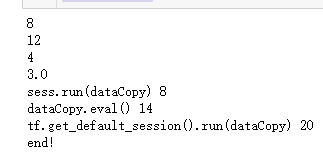
3、矩阵
placehold 预定义变量
#placehold 预定义
import tensorflow as tf
data1 = tf.placeholder(tf.float32)
data2 = tf.placeholder(tf.float32)
dataAdd = tf.add(data1,data2)
with tf.session() as sess:
print(sess.run(dataAdd,feed_dict=(data1:6,data2:2)))
# 1 dataAdd 2 data (feed_dict = {1:6 2})
print('end')
基本操作
import tensorflow as tf
data1 = tf.constant([[6,6]])
data2 = tf.constant([[2],
[2]])
data3 = tf.constant([[3,3]])
data4 = tf.constant([[1,2],[3,4],[5,6]])
print(data4.shape)#打印维度
with tf.Session() as sess:
print(sess.run(data4))#打印整体内容
print(sess.run(data4[0]))#打印某一行
print(sess.run(data4[:,1]))#打印某一列
print(sess.run(data4[1,1]))#打印第一行第一列
基本操作
import tensorflow as tf
data1 = tf.constant([[6,6]])
data2 = tf.constant([[2],
[2]])
data3 = tf.constant([[3,3]])
data4 = tf.constant([[1,2],[3,4],[5,6]])
matAdd = tf.add(data1,data3)
matMul = tf.matmul(data1,data2)
with tf.Session() as sess:
print(sess.run(matMul))
print(sess.run(matAdd))
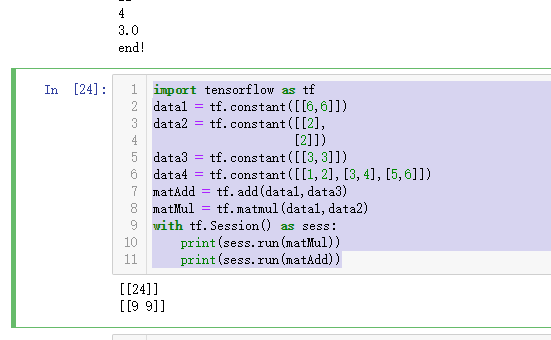
import tensorflow as tf
mat0 = tf.constant([[0,0,0],[0,0,0]])
mat1 = tf.zeros([2,3])
mat2 = tf.ones([3,2])
mat3 = tf.fill([2,3],15)
with tf.Session() as sess:
#print(sess.run(mat0))
print(sess.run(mat1))
print(sess.run(mat2))
print(sess.run(mat3))
运行结果:

import tensorflow as tf
mat1 = tf.constant([[2],[3],[4]])
mat2 = tf.zeros_like(mat1)
mat3 = tf.linspace(0.0,2.0,11)
mat4 = tf.random_uniform([2,3],-1,2)
with tf.Session() as sess:
print(sess.run(mat2))
print(sess.run(mat3))
print(sess.run(mat4))

四、Numpy的使用
#CRUD
import numpy as np
data1 = np.array([1,2,3,4,5])
print(data1)
data2 = np.array([[1,2],
[3,4]])
print(data2)
#维度
print(data1.shape,data2.shape)
#zero ones 单位矩阵
print(np.zeros([2,3]),np.ones([2,2]))
#改查
data2[1,0] = 5
print(data2)
print(data2[1,1])
#加减乘除
data3 = np.ones([2,3])
print(data3*2)
print(data3/3)
print(data3+2)
print(data3-3)
#矩阵的加法和乘法
data4 = np.array([[1,2,3],[4,5,6]])
print(data3+data4)
#
五、matplotlib的使用
绘制折线图
import numpy as np
import matplotlib.pyplot as plt
x = np.array([1,2,3,4,5,6,7,8])
y = np.array([3,4,7,6,2,7,10,15])
plt.plot(x,y,'r')#绘制 1 折线图 1x 2 y 3 color

柱状图:
import numpy as np
import matplotlib.pyplot as plt
x = np.array([1,2,3,4,5,6,7,8])
y = np.array([3,4,7,6,2,7,10,15])
plt.plot(x,y,'r')#绘制 1 折线图 1x 2 y 3 color
plt.plot(x,y,'g',lw=10) #4 line w
# 折线 饼状 柱状
plt.bar(x,y,0.5,alpha=1,color='b')
plt.show()
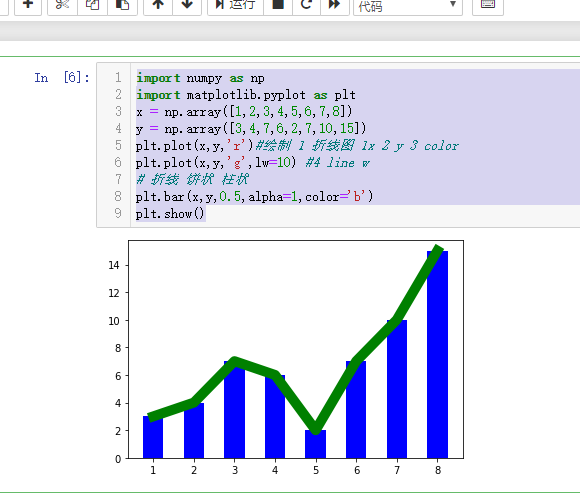
神经网络逼近股票收盘价格
首先绘制K线
import tensorflow as tf
import numpy as np
import matplotlib.pyplot as plt
date = np.linspace(1,15,15)
endPrice = np.array([2511.90,2538.26,2510.68,2591.66,2732.98,2701.69,2701.29,2678.67,2726.50,2681.50,2739.17,2715.07,2823.58,2864.90,2919.08])
beginPrice = np.array([2438.71,2500.88,2534.95,2512.52,2594.04,2743.26,2697.47,2695.24,2678.23,2722.13,2674.93,2744.13,2717.46,2832.73,2877.40])
print(date)
plt.figure()
for i in range(0,15):
# 1 柱状图
dateOne = np.zeros([2])
dateOne[0] = i;
dateOne[1] = i;
priceOne = np.zeros([2])
priceOne[0] = beginPrice[i]
priceOne[1] = endPrice[i]
if endPrice[i]>beginPrice[i]:
plt.plot(dateOne,priceOne,'r',lw=8)
else:
plt.plot(dateOne,priceOne,'g',lw=8)
plt.show()
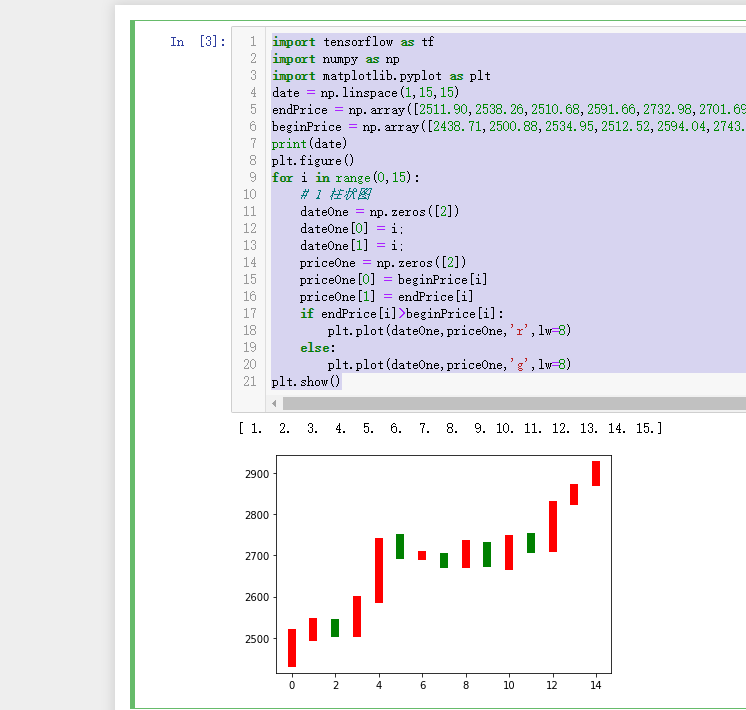
实现人工神经网络:
分为三层:
1、输入层
2、中间层(隐藏层)
3、输出层
在这里面 输入矩阵为15 x 1
隐藏层矩阵 1x10的矩阵
输出层 输出矩阵
15 x 1
实现的功能:
通过天数输入 输出每天对应的股价
隐藏层
A*W1+b1 = B
B*w2+b2 = C
A:输入层 B:隐藏层 C:输出层 W1 1x10 B1 1x10偏移矩阵
代码如下:
# layer1:激励函数+乘加运算
import tensorflow as tf
import numpy as np
import matplotlib.pyplot as plt
date = np.linspace(1,15,15)
endPrice = np.array([2511.90,2538.26,2510.68,2591.66,2732.98,2701.69,2701.29,2678.67,2726.50,2681.50,2739.17,2715.07,2823.58,2864.90,2919.08]
)
beginPrice = np.array([2438.71,2500.88,2534.95,2512.52,2594.04,2743.26,2697.47,2695.24,2678.23,2722.13,2674.93,2744.13,2717.46,2832.73,2877.40])
print(date)
plt.figure()
for i in range(0,15):
# 1 柱状图
dateOne = np.zeros([2])
dateOne[0] = i;
dateOne[1] = i;
priceOne = np.zeros([2])
priceOne[0] = beginPrice[i]
priceOne[1] = endPrice[i]
if endPrice[i]>beginPrice[i]:
plt.plot(dateOne,priceOne,'r',lw=8)
else:
plt.plot(dateOne,priceOne,'g',lw=8)
#plt.show()
# A(15x1)*w1(1x10)+b1(1*10) = B(15x10)
# B(15x10)*w2(10x1)+b2(15x1) = C(15x1)
# 1 A B C
dateNormal = np.zeros([15,1])
priceNormal = np.zeros([15,1])
for i in range(0,15):
dateNormal[i,0] = i/14.0;
priceNormal[i,0] = endPrice[i]/3000.0;
x = tf.placeholder(tf.float32,[None,1])
y = tf.placeholder(tf.float32,[None,1])
# B
w1 = tf.Variable(tf.random_uniform([1,10],0,1))
b1 = tf.Variable(tf.zeros([1,10]))
wb1 = tf.matmul(x,w1)+b1
layer1 = tf.nn.relu(wb1) # 激励函数
# C
w2 = tf.Variable(tf.random_uniform([10,1],0,1))
b2 = tf.Variable(tf.zeros([15,1]))
wb2 = tf.matmul(layer1,w2)+b2
layer2 = tf.nn.relu(wb2)
loss = tf.reduce_mean(tf.square(y-layer2))#y 真实 layer2 计算
train_step = tf.train.GradientDescentOptimizer(0.1).minimize(loss)
with tf.Session() as sess:
sess.run(tf.global_variables_initializer())
for i in range(0,10000):
sess.run(train_step,feed_dict={x:dateNormal,y:priceNormal})
# w1w2 b1b2 A + wb -->layer2
pred = sess.run(layer2,feed_dict={x:dateNormal})
predPrice = np.zeros([15,1])
for i in range(0,15):
predPrice[i,0]=(pred*3000)[i,0]
plt.plot(date,predPrice,'b',lw=1)
plt.show()
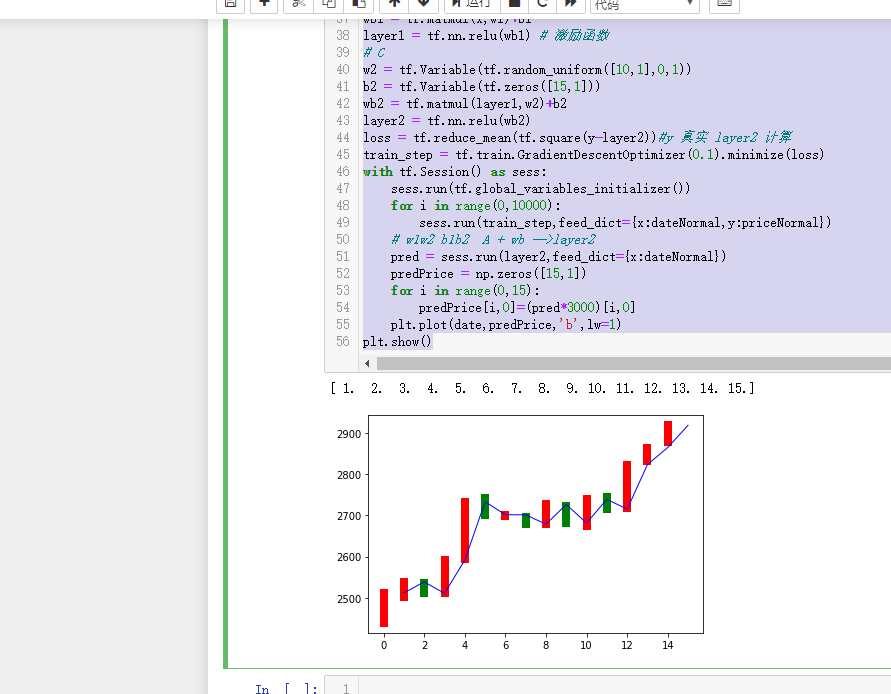
预计结果基本上吻合
TensorFlow、numpy、matplotlib、基本操作的更多相关文章
- 在mac安装numpy matplotlib scipy
p.p1 { margin: 0.0px 0.0px 0.0px 0.0px; font: 11.0px Menlo; color: #000000; background-color: #fffff ...
- Ubuntu-Python2.7安装 scipy,numpy,matplotlib 和pip
一. scipy,numpy,matplotlib sudo apt-get install python-scipy sudo apt-get install python-numpy sudo a ...
- NumPy Matplotlib库
NumPy - Matplotlib Matplotlib 是 Python 的绘图库. 它可与 NumPy 一起使用,提供了一种有效的 MatLab 开源替代方案. 它也可以和图形工具包一起使用,如 ...
- 21、numpy—Matplotlib
NumPy Matplotlib Matplotlib 是 Python 的绘图库. 它可与 NumPy 一起使用,提供了一种有效的 MatLab 开源替代方案. 它也可以和图形工具包一起使用,如 P ...
- 【学习总结】GirlsInAI ML-diary day-21-初识 Numpy, Matplotlib, Seanborn [柱状图、折线图、箱图]
[学习总结]GirlsInAI ML-diary 总 原博github链接-day21 初识 Numpy, Matplotlib, Seanborn [柱状图.折线图.箱图] 一.Titanic练习赛 ...
- Windows系统在Python2.7环境下安装numpy, matplotlib, scipy - Lichanghao Blog
numpy, matplotlib, scipy三个包是科学计算和绘图的利器.安装它们既可以在网上下载exe安装包,也可以用python内置的包管理工具来下载安装,后者较为方便. 这几天做美赛要用到, ...
- NumPy的基本操作
1 简介 NumPy 是用于处理数组的 python 库,部分用 Python 编写,但是大多数需要快速计算的部分都是用 C 或 C ++ 编写的.它还拥有在线性代数.傅立叶变换和矩阵领域中工作的函数 ...
- (零)机器学习入门与经典算法之numpy的基本操作
1.根据索引来获取元素* 创建一个索引列表ind,用来装载索引,当numpy数据是一维数据时:一个索引对应的是一个元素具体的例子如下: import numpy as np # 数据是一维数据时:索引 ...
- 利用numpy+matplotlib绘图的基本操作教程
简述 Matplotlib是一个基于python的2D画图库,能够用python脚本方便的画出折线图,直方图,功率谱图,散点图等常用图表,而且语法简单.具体介绍见matplot官网. Numpy(Nu ...
- numpy&matplotlib读书笔记
Matplotlib matplotlib是Python优秀的数据可视化第三方库 matplotlib库的效果可参考 http://matplotlib.org/gallery.html matplo ...
随机推荐
- QML::Rectangle组件
QML的Rectangle组件,描绘一个矩形,一个可视化的对象. 外加设置属性来达到我们想要的效果.常用的有矩形的颜色,边框颜色,圆角等设置. Rectangle{ x:10//这里的坐标是相对于它的 ...
- 浅入浅出 Go 语言接口的原理
浅入浅出 Go 语言接口的原理 接口是 Go 语言的重要组成部分,它在 Go 语言中通过一组方法指定了一个对象的行为,接口 interface 的引入能够让我们在 Go 语言更好地组织并写出易于测试的 ...
- [N久以前发布的文章]php 获取yahoo股票csv数据并封闭成为接口输出json数据
思路 先从yahoo接口获取数据,再定义接口,转化成为json输出.只供卡通网(kt5.cn)使用 stock.php 接口处理代码 <?php header("Content-Typ ...
- impdp中的DISABLE_ARCHIVE_LOGGING参数测试
impdp中的DISABLE_ARCHIVE_LOGGING参数测试 发表于 2017 年 04 月 08 日 由 惜分飞 联系:手机/微信(+86 13429648788) QQ(107644445 ...
- linux查询及添加用户
1.查询用户. 存储帐号的文件:/etc/passwd 存储密码的文件:/etc/shadow Cat /etc/passwd Cat /etc/shadow 2.添加用户 输入命令: usera ...
- Master Note: Troubleshooting ORA-1548 error (Doc ID 1577988.1)
APPLIES TO: Oracle Database Cloud Schema Service - Version N/A and laterOracle Database Exadata Clou ...
- ISODATA聚类算法的matlab程序
ISODATA聚类算法的matlab程序 作者:凯鲁嘎吉 - 博客园 http://www.cnblogs.com/kailugaji/ 参考:Kmeans及ISODATA算法的matlab实现 算法 ...
- vue实现点击图标,图标在2s中完成旋转
<!-- 点击 vue实现点击图标,图标在2s中完成旋转 1==>如何让它在2s内完成旋转 使用动画 transform: rotate(-180deg); 动画的运动状态 transit ...
- vue调用高德地图:vue-amap
前言:之前没有接触过页面调用地图的项目,某次面试,老板要求我用vue-amap调用高德地图,回家以后,我去网上查了一些案例和教程,看似很简单的引入调用,我却整整弄了一宿,还没弄出来!!!百般无奈之下, ...
- verilog 常见单元描述
半加器: //行为级建模 module half_adder2(a, b, sum, c_out); input a, b; output sum, c_out; assign {c_out, sum ...
